Leadership and Management Theories
VerifiedAdded on 2020/02/24
|12
|3543
|97
AI Summary
This assignment delves into the world of leadership and management theories. It requires a comprehensive understanding of various theoretical approaches, including classical, behavioral, contingency, and transformational theories. Students are expected to analyze and compare different models, highlighting their strengths, weaknesses, and applications in real-world scenarios. The assignment emphasizes critical thinking, research skills, and the ability to synthesize complex information about organizational dynamics.
Contribute Materials
Your contribution can guide someone’s learning journey. Share your
documents today.
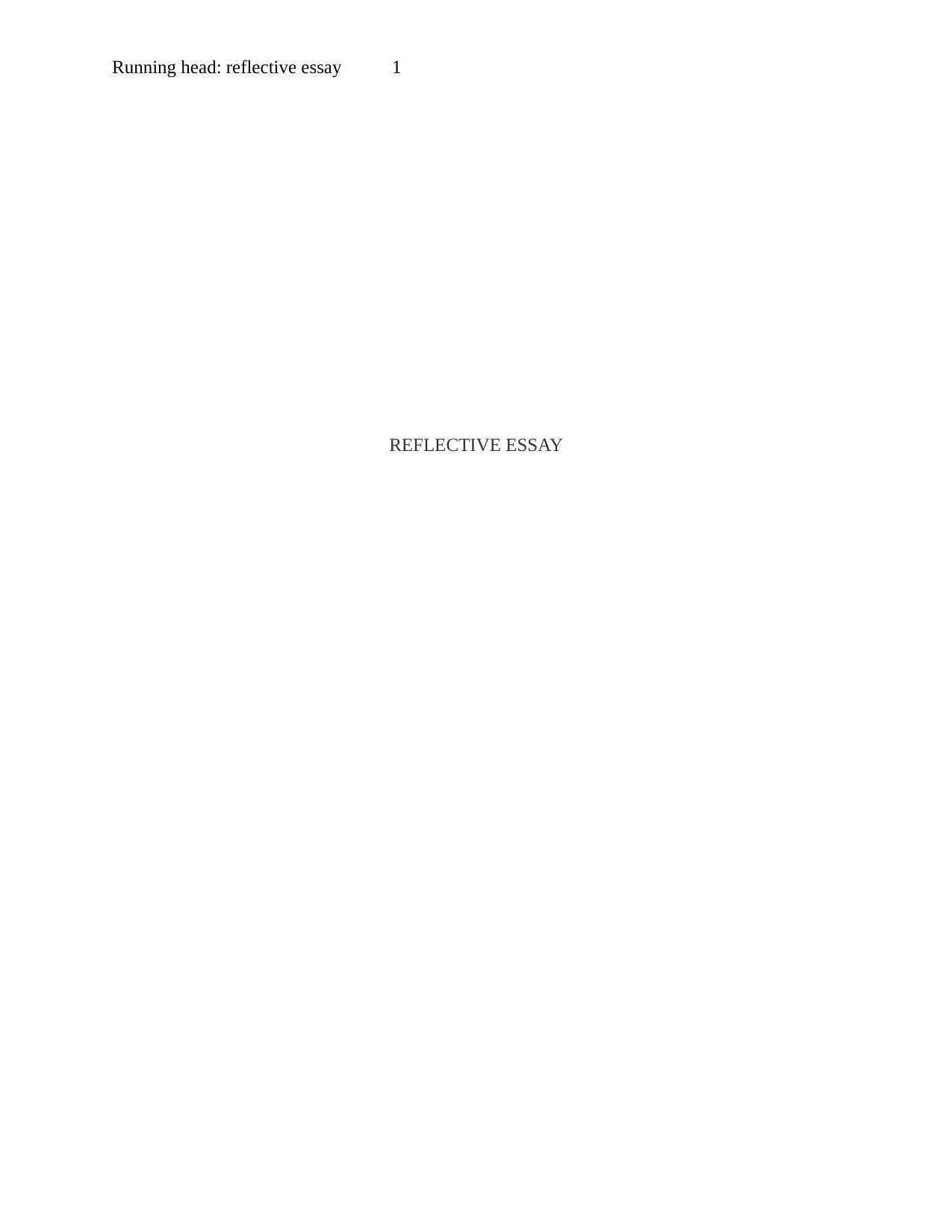
Running head: reflective essay 1
REFLECTIVE ESSAY
REFLECTIVE ESSAY
Secure Best Marks with AI Grader
Need help grading? Try our AI Grader for instant feedback on your assignments.
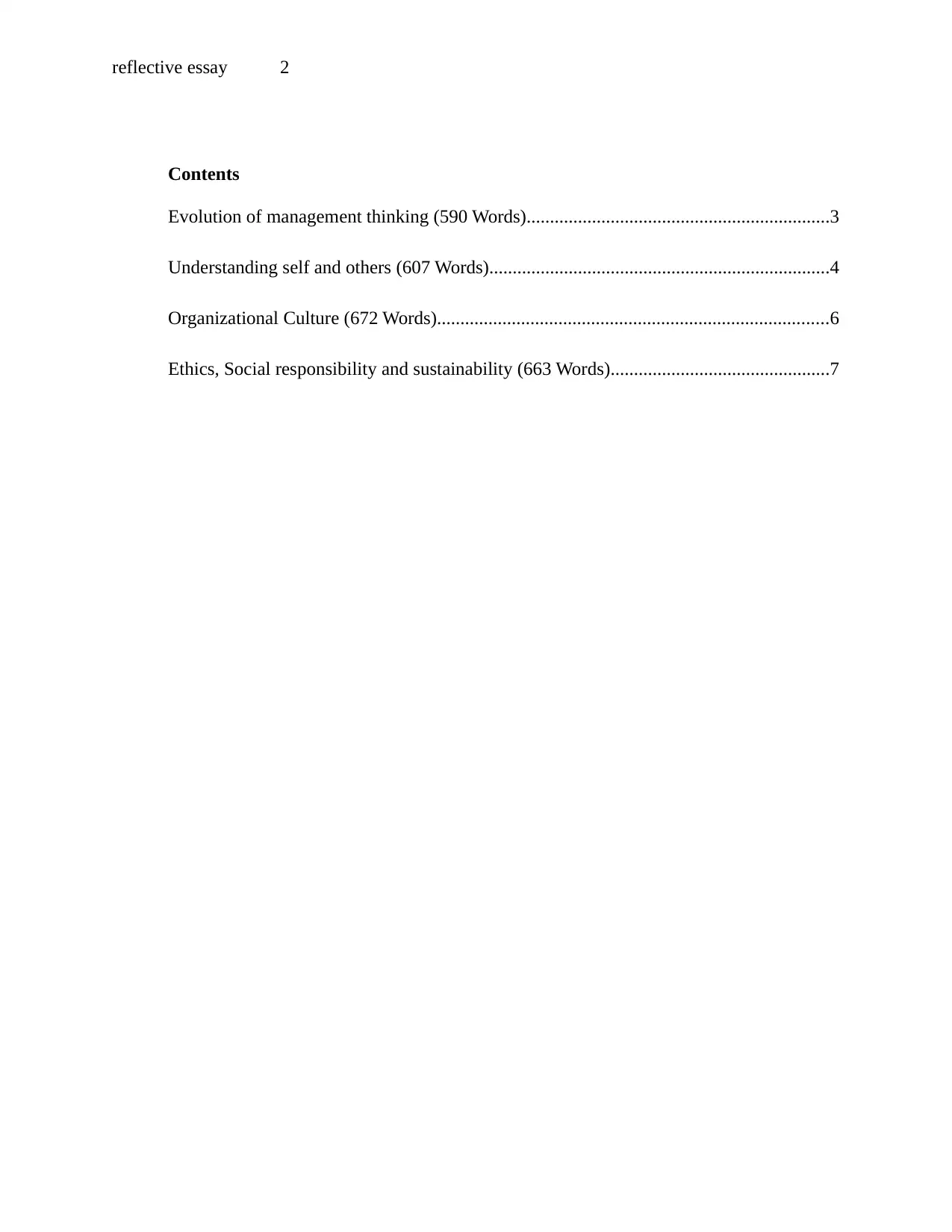
reflective essay 2
Contents
Evolution of management thinking (590 Words).................................................................3
Understanding self and others (607 Words).........................................................................4
Organizational Culture (672 Words)....................................................................................6
Ethics, Social responsibility and sustainability (663 Words)...............................................7
Contents
Evolution of management thinking (590 Words).................................................................3
Understanding self and others (607 Words).........................................................................4
Organizational Culture (672 Words)....................................................................................6
Ethics, Social responsibility and sustainability (663 Words)...............................................7
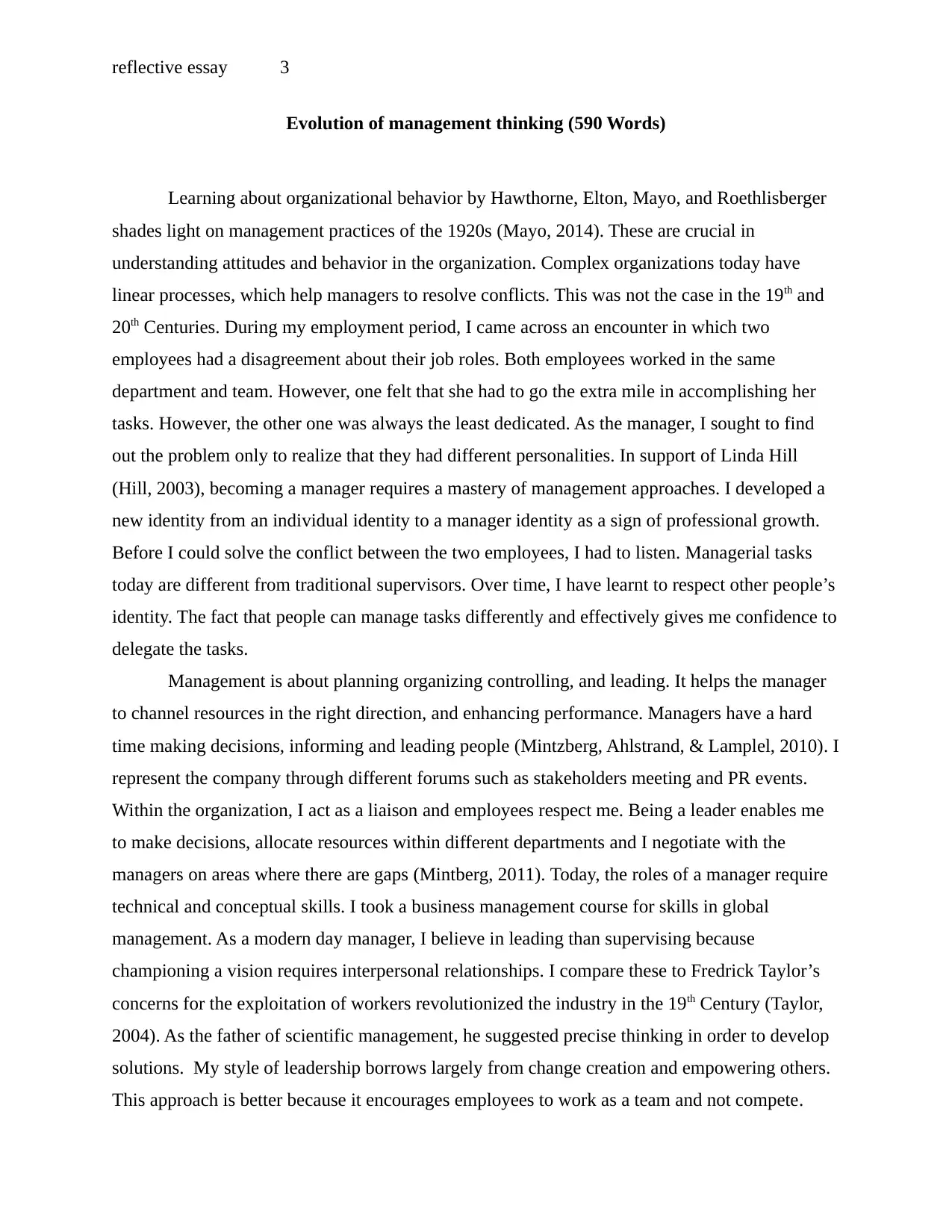
reflective essay 3
Evolution of management thinking (590 Words)
Learning about organizational behavior by Hawthorne, Elton, Mayo, and Roethlisberger
shades light on management practices of the 1920s (Mayo, 2014). These are crucial in
understanding attitudes and behavior in the organization. Complex organizations today have
linear processes, which help managers to resolve conflicts. This was not the case in the 19th and
20th Centuries. During my employment period, I came across an encounter in which two
employees had a disagreement about their job roles. Both employees worked in the same
department and team. However, one felt that she had to go the extra mile in accomplishing her
tasks. However, the other one was always the least dedicated. As the manager, I sought to find
out the problem only to realize that they had different personalities. In support of Linda Hill
(Hill, 2003), becoming a manager requires a mastery of management approaches. I developed a
new identity from an individual identity to a manager identity as a sign of professional growth.
Before I could solve the conflict between the two employees, I had to listen. Managerial tasks
today are different from traditional supervisors. Over time, I have learnt to respect other people’s
identity. The fact that people can manage tasks differently and effectively gives me confidence to
delegate the tasks.
Management is about planning organizing controlling, and leading. It helps the manager
to channel resources in the right direction, and enhancing performance. Managers have a hard
time making decisions, informing and leading people (Mintzberg, Ahlstrand, & Lamplel, 2010). I
represent the company through different forums such as stakeholders meeting and PR events.
Within the organization, I act as a liaison and employees respect me. Being a leader enables me
to make decisions, allocate resources within different departments and I negotiate with the
managers on areas where there are gaps (Mintberg, 2011). Today, the roles of a manager require
technical and conceptual skills. I took a business management course for skills in global
management. As a modern day manager, I believe in leading than supervising because
championing a vision requires interpersonal relationships. I compare these to Fredrick Taylor’s
concerns for the exploitation of workers revolutionized the industry in the 19th Century (Taylor,
2004). As the father of scientific management, he suggested precise thinking in order to develop
solutions. My style of leadership borrows largely from change creation and empowering others.
This approach is better because it encourages employees to work as a team and not compete.
Evolution of management thinking (590 Words)
Learning about organizational behavior by Hawthorne, Elton, Mayo, and Roethlisberger
shades light on management practices of the 1920s (Mayo, 2014). These are crucial in
understanding attitudes and behavior in the organization. Complex organizations today have
linear processes, which help managers to resolve conflicts. This was not the case in the 19th and
20th Centuries. During my employment period, I came across an encounter in which two
employees had a disagreement about their job roles. Both employees worked in the same
department and team. However, one felt that she had to go the extra mile in accomplishing her
tasks. However, the other one was always the least dedicated. As the manager, I sought to find
out the problem only to realize that they had different personalities. In support of Linda Hill
(Hill, 2003), becoming a manager requires a mastery of management approaches. I developed a
new identity from an individual identity to a manager identity as a sign of professional growth.
Before I could solve the conflict between the two employees, I had to listen. Managerial tasks
today are different from traditional supervisors. Over time, I have learnt to respect other people’s
identity. The fact that people can manage tasks differently and effectively gives me confidence to
delegate the tasks.
Management is about planning organizing controlling, and leading. It helps the manager
to channel resources in the right direction, and enhancing performance. Managers have a hard
time making decisions, informing and leading people (Mintzberg, Ahlstrand, & Lamplel, 2010). I
represent the company through different forums such as stakeholders meeting and PR events.
Within the organization, I act as a liaison and employees respect me. Being a leader enables me
to make decisions, allocate resources within different departments and I negotiate with the
managers on areas where there are gaps (Mintberg, 2011). Today, the roles of a manager require
technical and conceptual skills. I took a business management course for skills in global
management. As a modern day manager, I believe in leading than supervising because
championing a vision requires interpersonal relationships. I compare these to Fredrick Taylor’s
concerns for the exploitation of workers revolutionized the industry in the 19th Century (Taylor,
2004). As the father of scientific management, he suggested precise thinking in order to develop
solutions. My style of leadership borrows largely from change creation and empowering others.
This approach is better because it encourages employees to work as a team and not compete.
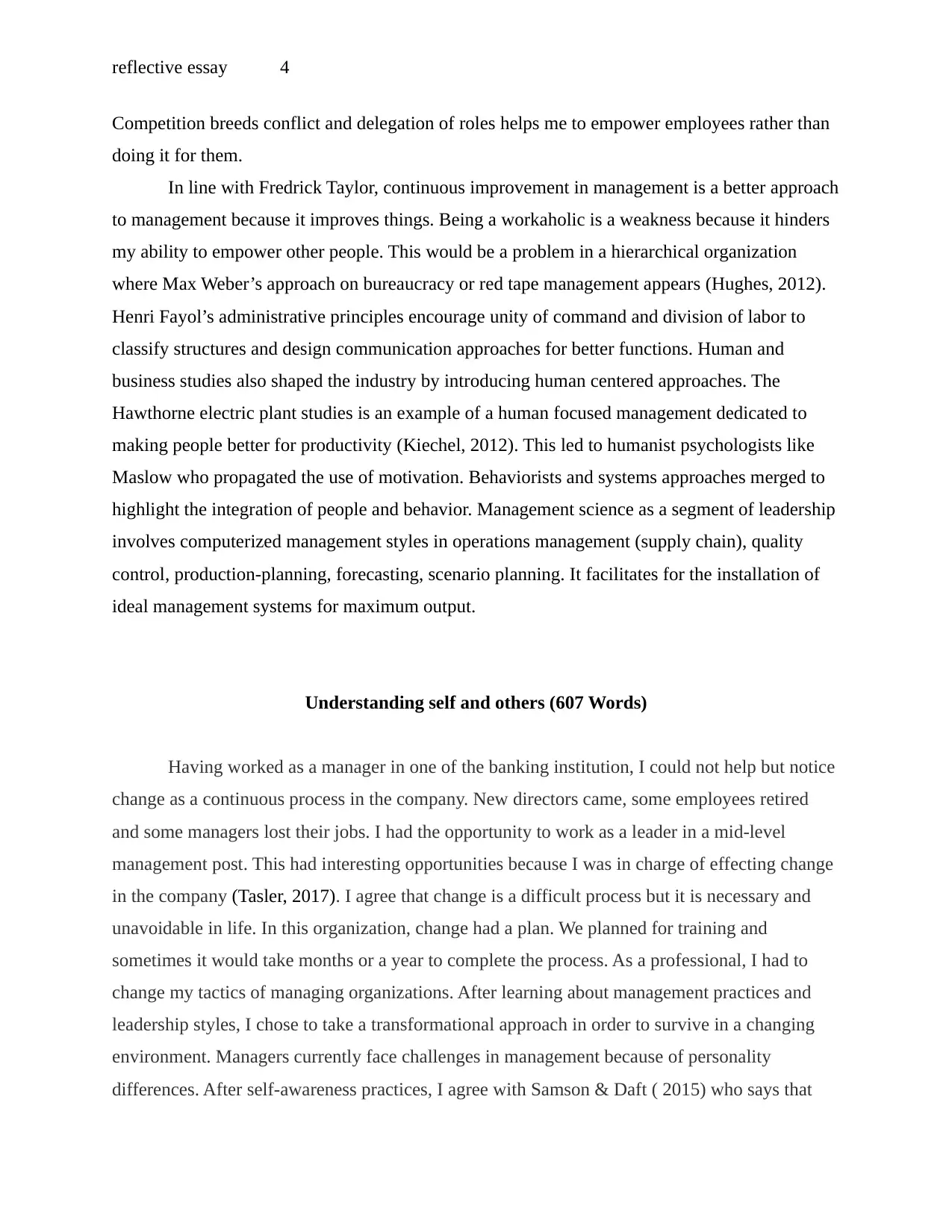
reflective essay 4
Competition breeds conflict and delegation of roles helps me to empower employees rather than
doing it for them.
In line with Fredrick Taylor, continuous improvement in management is a better approach
to management because it improves things. Being a workaholic is a weakness because it hinders
my ability to empower other people. This would be a problem in a hierarchical organization
where Max Weber’s approach on bureaucracy or red tape management appears (Hughes, 2012).
Henri Fayol’s administrative principles encourage unity of command and division of labor to
classify structures and design communication approaches for better functions. Human and
business studies also shaped the industry by introducing human centered approaches. The
Hawthorne electric plant studies is an example of a human focused management dedicated to
making people better for productivity (Kiechel, 2012). This led to humanist psychologists like
Maslow who propagated the use of motivation. Behaviorists and systems approaches merged to
highlight the integration of people and behavior. Management science as a segment of leadership
involves computerized management styles in operations management (supply chain), quality
control, production-planning, forecasting, scenario planning. It facilitates for the installation of
ideal management systems for maximum output.
Understanding self and others (607 Words)
Having worked as a manager in one of the banking institution, I could not help but notice
change as a continuous process in the company. New directors came, some employees retired
and some managers lost their jobs. I had the opportunity to work as a leader in a mid-level
management post. This had interesting opportunities because I was in charge of effecting change
in the company (Tasler, 2017). I agree that change is a difficult process but it is necessary and
unavoidable in life. In this organization, change had a plan. We planned for training and
sometimes it would take months or a year to complete the process. As a professional, I had to
change my tactics of managing organizations. After learning about management practices and
leadership styles, I chose to take a transformational approach in order to survive in a changing
environment. Managers currently face challenges in management because of personality
differences. After self-awareness practices, I agree with Samson & Daft ( 2015) who says that
Competition breeds conflict and delegation of roles helps me to empower employees rather than
doing it for them.
In line with Fredrick Taylor, continuous improvement in management is a better approach
to management because it improves things. Being a workaholic is a weakness because it hinders
my ability to empower other people. This would be a problem in a hierarchical organization
where Max Weber’s approach on bureaucracy or red tape management appears (Hughes, 2012).
Henri Fayol’s administrative principles encourage unity of command and division of labor to
classify structures and design communication approaches for better functions. Human and
business studies also shaped the industry by introducing human centered approaches. The
Hawthorne electric plant studies is an example of a human focused management dedicated to
making people better for productivity (Kiechel, 2012). This led to humanist psychologists like
Maslow who propagated the use of motivation. Behaviorists and systems approaches merged to
highlight the integration of people and behavior. Management science as a segment of leadership
involves computerized management styles in operations management (supply chain), quality
control, production-planning, forecasting, scenario planning. It facilitates for the installation of
ideal management systems for maximum output.
Understanding self and others (607 Words)
Having worked as a manager in one of the banking institution, I could not help but notice
change as a continuous process in the company. New directors came, some employees retired
and some managers lost their jobs. I had the opportunity to work as a leader in a mid-level
management post. This had interesting opportunities because I was in charge of effecting change
in the company (Tasler, 2017). I agree that change is a difficult process but it is necessary and
unavoidable in life. In this organization, change had a plan. We planned for training and
sometimes it would take months or a year to complete the process. As a professional, I had to
change my tactics of managing organizations. After learning about management practices and
leadership styles, I chose to take a transformational approach in order to survive in a changing
environment. Managers currently face challenges in management because of personality
differences. After self-awareness practices, I agree with Samson & Daft ( 2015) who says that
Secure Best Marks with AI Grader
Need help grading? Try our AI Grader for instant feedback on your assignments.
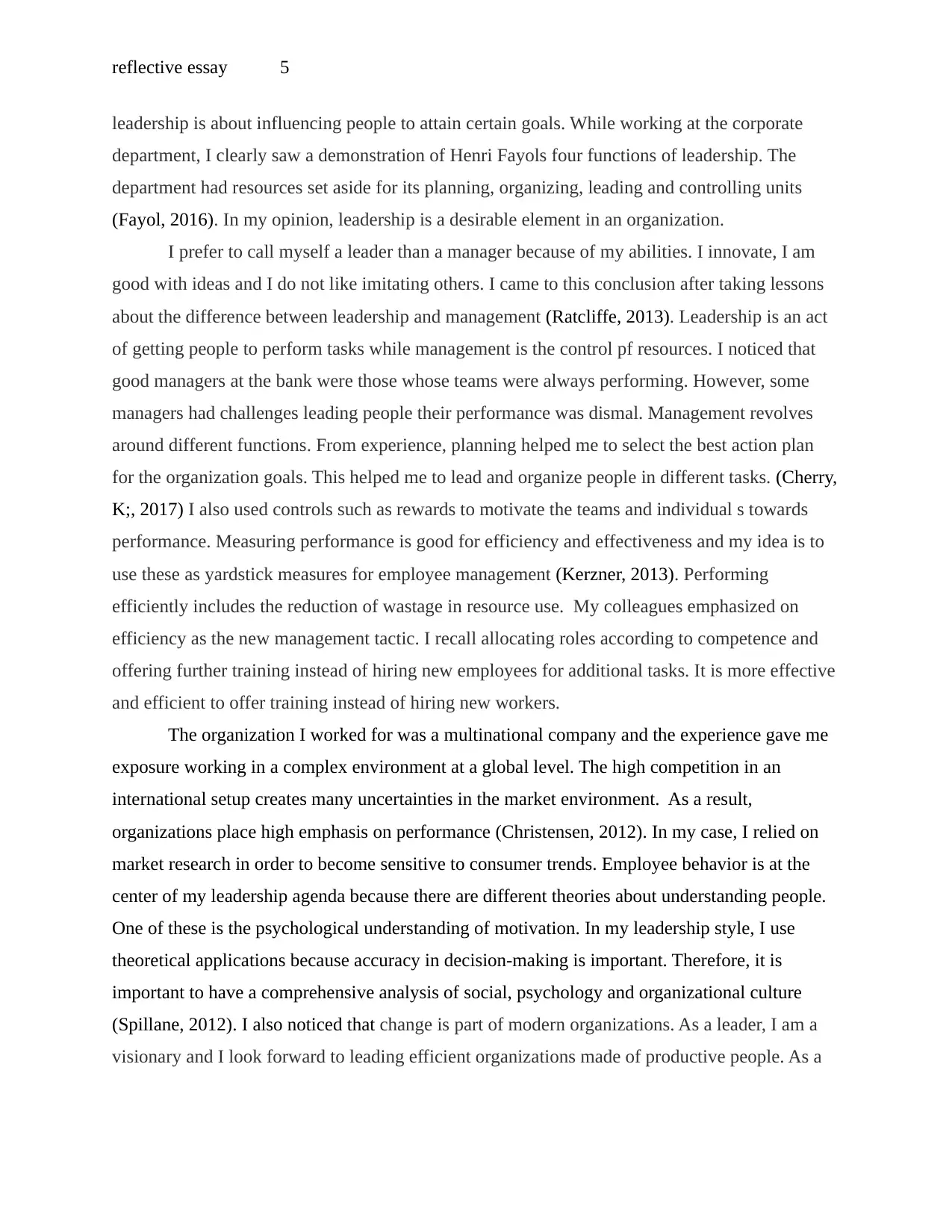
reflective essay 5
leadership is about influencing people to attain certain goals. While working at the corporate
department, I clearly saw a demonstration of Henri Fayols four functions of leadership. The
department had resources set aside for its planning, organizing, leading and controlling units
(Fayol, 2016). In my opinion, leadership is a desirable element in an organization.
I prefer to call myself a leader than a manager because of my abilities. I innovate, I am
good with ideas and I do not like imitating others. I came to this conclusion after taking lessons
about the difference between leadership and management (Ratcliffe, 2013). Leadership is an act
of getting people to perform tasks while management is the control pf resources. I noticed that
good managers at the bank were those whose teams were always performing. However, some
managers had challenges leading people their performance was dismal. Management revolves
around different functions. From experience, planning helped me to select the best action plan
for the organization goals. This helped me to lead and organize people in different tasks. (Cherry,
K;, 2017) I also used controls such as rewards to motivate the teams and individual s towards
performance. Measuring performance is good for efficiency and effectiveness and my idea is to
use these as yardstick measures for employee management (Kerzner, 2013). Performing
efficiently includes the reduction of wastage in resource use. My colleagues emphasized on
efficiency as the new management tactic. I recall allocating roles according to competence and
offering further training instead of hiring new employees for additional tasks. It is more effective
and efficient to offer training instead of hiring new workers.
The organization I worked for was a multinational company and the experience gave me
exposure working in a complex environment at a global level. The high competition in an
international setup creates many uncertainties in the market environment. As a result,
organizations place high emphasis on performance (Christensen, 2012). In my case, I relied on
market research in order to become sensitive to consumer trends. Employee behavior is at the
center of my leadership agenda because there are different theories about understanding people.
One of these is the psychological understanding of motivation. In my leadership style, I use
theoretical applications because accuracy in decision-making is important. Therefore, it is
important to have a comprehensive analysis of social, psychology and organizational culture
(Spillane, 2012). I also noticed that change is part of modern organizations. As a leader, I am a
visionary and I look forward to leading efficient organizations made of productive people. As a
leadership is about influencing people to attain certain goals. While working at the corporate
department, I clearly saw a demonstration of Henri Fayols four functions of leadership. The
department had resources set aside for its planning, organizing, leading and controlling units
(Fayol, 2016). In my opinion, leadership is a desirable element in an organization.
I prefer to call myself a leader than a manager because of my abilities. I innovate, I am
good with ideas and I do not like imitating others. I came to this conclusion after taking lessons
about the difference between leadership and management (Ratcliffe, 2013). Leadership is an act
of getting people to perform tasks while management is the control pf resources. I noticed that
good managers at the bank were those whose teams were always performing. However, some
managers had challenges leading people their performance was dismal. Management revolves
around different functions. From experience, planning helped me to select the best action plan
for the organization goals. This helped me to lead and organize people in different tasks. (Cherry,
K;, 2017) I also used controls such as rewards to motivate the teams and individual s towards
performance. Measuring performance is good for efficiency and effectiveness and my idea is to
use these as yardstick measures for employee management (Kerzner, 2013). Performing
efficiently includes the reduction of wastage in resource use. My colleagues emphasized on
efficiency as the new management tactic. I recall allocating roles according to competence and
offering further training instead of hiring new employees for additional tasks. It is more effective
and efficient to offer training instead of hiring new workers.
The organization I worked for was a multinational company and the experience gave me
exposure working in a complex environment at a global level. The high competition in an
international setup creates many uncertainties in the market environment. As a result,
organizations place high emphasis on performance (Christensen, 2012). In my case, I relied on
market research in order to become sensitive to consumer trends. Employee behavior is at the
center of my leadership agenda because there are different theories about understanding people.
One of these is the psychological understanding of motivation. In my leadership style, I use
theoretical applications because accuracy in decision-making is important. Therefore, it is
important to have a comprehensive analysis of social, psychology and organizational culture
(Spillane, 2012). I also noticed that change is part of modern organizations. As a leader, I am a
visionary and I look forward to leading efficient organizations made of productive people. As a
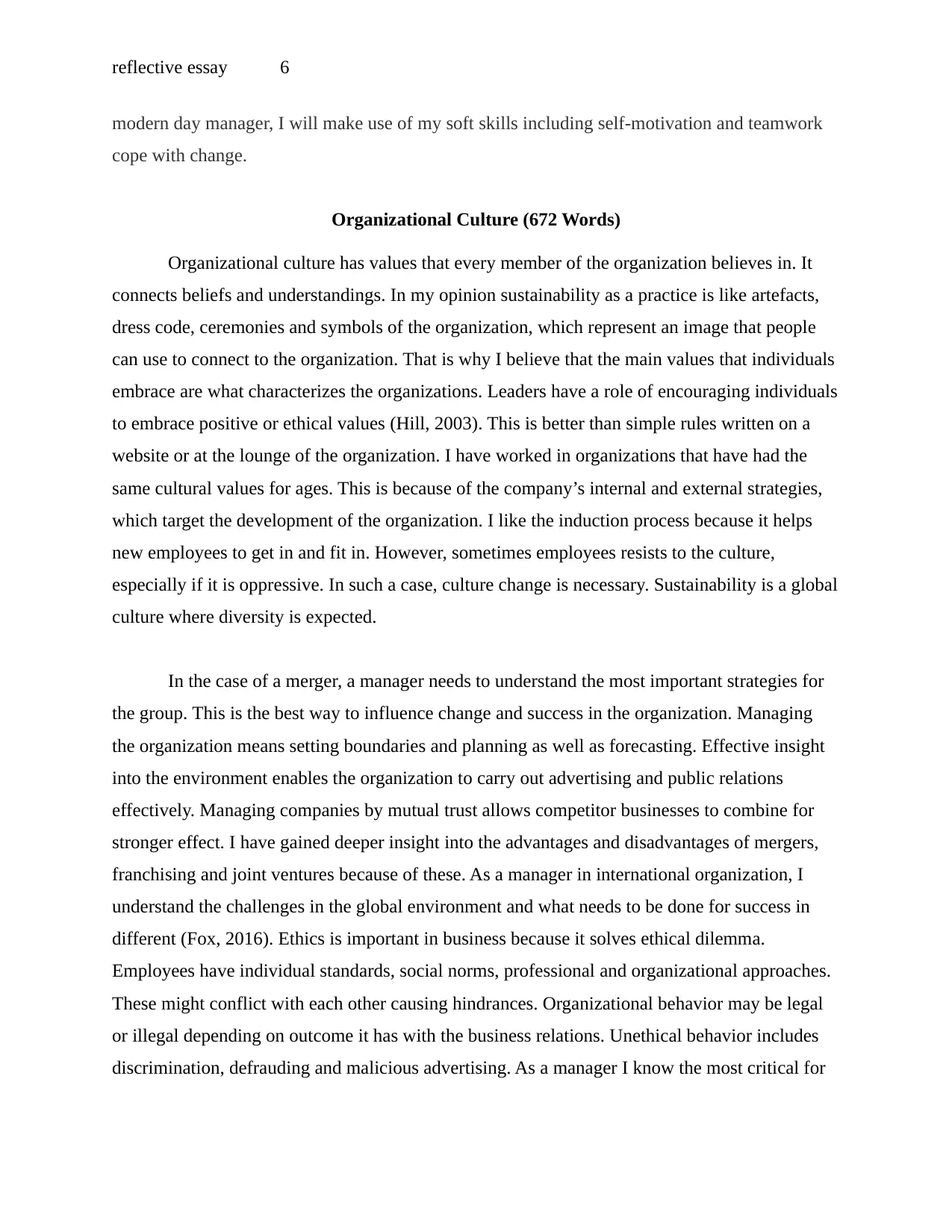
reflective essay 6
modern day manager, I will make use of my soft skills including self-motivation and teamwork
cope with change.
Organizational Culture (672 Words)
Organizational culture has values that every member of the organization believes in. It
connects beliefs and understandings. In my opinion sustainability as a practice is like artefacts,
dress code, ceremonies and symbols of the organization, which represent an image that people
can use to connect to the organization. That is why I believe that the main values that individuals
embrace are what characterizes the organizations. Leaders have a role of encouraging individuals
to embrace positive or ethical values (Hill, 2003). This is better than simple rules written on a
website or at the lounge of the organization. I have worked in organizations that have had the
same cultural values for ages. This is because of the company’s internal and external strategies,
which target the development of the organization. I like the induction process because it helps
new employees to get in and fit in. However, sometimes employees resists to the culture,
especially if it is oppressive. In such a case, culture change is necessary. Sustainability is a global
culture where diversity is expected.
In the case of a merger, a manager needs to understand the most important strategies for
the group. This is the best way to influence change and success in the organization. Managing
the organization means setting boundaries and planning as well as forecasting. Effective insight
into the environment enables the organization to carry out advertising and public relations
effectively. Managing companies by mutual trust allows competitor businesses to combine for
stronger effect. I have gained deeper insight into the advantages and disadvantages of mergers,
franchising and joint ventures because of these. As a manager in international organization, I
understand the challenges in the global environment and what needs to be done for success in
different (Fox, 2016). Ethics is important in business because it solves ethical dilemma.
Employees have individual standards, social norms, professional and organizational approaches.
These might conflict with each other causing hindrances. Organizational behavior may be legal
or illegal depending on outcome it has with the business relations. Unethical behavior includes
discrimination, defrauding and malicious advertising. As a manager I know the most critical for
modern day manager, I will make use of my soft skills including self-motivation and teamwork
cope with change.
Organizational Culture (672 Words)
Organizational culture has values that every member of the organization believes in. It
connects beliefs and understandings. In my opinion sustainability as a practice is like artefacts,
dress code, ceremonies and symbols of the organization, which represent an image that people
can use to connect to the organization. That is why I believe that the main values that individuals
embrace are what characterizes the organizations. Leaders have a role of encouraging individuals
to embrace positive or ethical values (Hill, 2003). This is better than simple rules written on a
website or at the lounge of the organization. I have worked in organizations that have had the
same cultural values for ages. This is because of the company’s internal and external strategies,
which target the development of the organization. I like the induction process because it helps
new employees to get in and fit in. However, sometimes employees resists to the culture,
especially if it is oppressive. In such a case, culture change is necessary. Sustainability is a global
culture where diversity is expected.
In the case of a merger, a manager needs to understand the most important strategies for
the group. This is the best way to influence change and success in the organization. Managing
the organization means setting boundaries and planning as well as forecasting. Effective insight
into the environment enables the organization to carry out advertising and public relations
effectively. Managing companies by mutual trust allows competitor businesses to combine for
stronger effect. I have gained deeper insight into the advantages and disadvantages of mergers,
franchising and joint ventures because of these. As a manager in international organization, I
understand the challenges in the global environment and what needs to be done for success in
different (Fox, 2016). Ethics is important in business because it solves ethical dilemma.
Employees have individual standards, social norms, professional and organizational approaches.
These might conflict with each other causing hindrances. Organizational behavior may be legal
or illegal depending on outcome it has with the business relations. Unethical behavior includes
discrimination, defrauding and malicious advertising. As a manager I know the most critical for
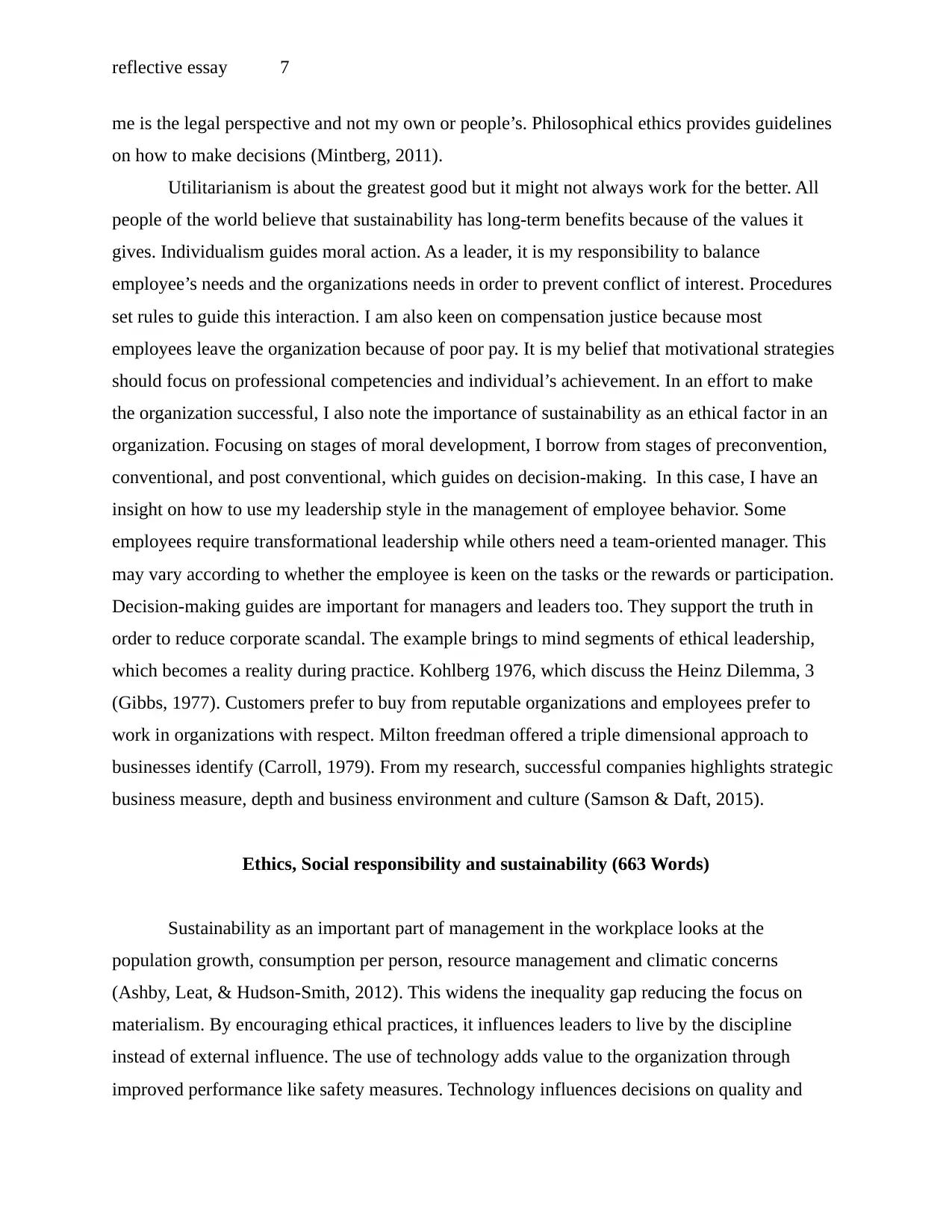
reflective essay 7
me is the legal perspective and not my own or people’s. Philosophical ethics provides guidelines
on how to make decisions (Mintberg, 2011).
Utilitarianism is about the greatest good but it might not always work for the better. All
people of the world believe that sustainability has long-term benefits because of the values it
gives. Individualism guides moral action. As a leader, it is my responsibility to balance
employee’s needs and the organizations needs in order to prevent conflict of interest. Procedures
set rules to guide this interaction. I am also keen on compensation justice because most
employees leave the organization because of poor pay. It is my belief that motivational strategies
should focus on professional competencies and individual’s achievement. In an effort to make
the organization successful, I also note the importance of sustainability as an ethical factor in an
organization. Focusing on stages of moral development, I borrow from stages of preconvention,
conventional, and post conventional, which guides on decision-making. In this case, I have an
insight on how to use my leadership style in the management of employee behavior. Some
employees require transformational leadership while others need a team-oriented manager. This
may vary according to whether the employee is keen on the tasks or the rewards or participation.
Decision-making guides are important for managers and leaders too. They support the truth in
order to reduce corporate scandal. The example brings to mind segments of ethical leadership,
which becomes a reality during practice. Kohlberg 1976, which discuss the Heinz Dilemma, 3
(Gibbs, 1977). Customers prefer to buy from reputable organizations and employees prefer to
work in organizations with respect. Milton freedman offered a triple dimensional approach to
businesses identify (Carroll, 1979). From my research, successful companies highlights strategic
business measure, depth and business environment and culture (Samson & Daft, 2015).
Ethics, Social responsibility and sustainability (663 Words)
Sustainability as an important part of management in the workplace looks at the
population growth, consumption per person, resource management and climatic concerns
(Ashby, Leat, & Hudson-Smith, 2012). This widens the inequality gap reducing the focus on
materialism. By encouraging ethical practices, it influences leaders to live by the discipline
instead of external influence. The use of technology adds value to the organization through
improved performance like safety measures. Technology influences decisions on quality and
me is the legal perspective and not my own or people’s. Philosophical ethics provides guidelines
on how to make decisions (Mintberg, 2011).
Utilitarianism is about the greatest good but it might not always work for the better. All
people of the world believe that sustainability has long-term benefits because of the values it
gives. Individualism guides moral action. As a leader, it is my responsibility to balance
employee’s needs and the organizations needs in order to prevent conflict of interest. Procedures
set rules to guide this interaction. I am also keen on compensation justice because most
employees leave the organization because of poor pay. It is my belief that motivational strategies
should focus on professional competencies and individual’s achievement. In an effort to make
the organization successful, I also note the importance of sustainability as an ethical factor in an
organization. Focusing on stages of moral development, I borrow from stages of preconvention,
conventional, and post conventional, which guides on decision-making. In this case, I have an
insight on how to use my leadership style in the management of employee behavior. Some
employees require transformational leadership while others need a team-oriented manager. This
may vary according to whether the employee is keen on the tasks or the rewards or participation.
Decision-making guides are important for managers and leaders too. They support the truth in
order to reduce corporate scandal. The example brings to mind segments of ethical leadership,
which becomes a reality during practice. Kohlberg 1976, which discuss the Heinz Dilemma, 3
(Gibbs, 1977). Customers prefer to buy from reputable organizations and employees prefer to
work in organizations with respect. Milton freedman offered a triple dimensional approach to
businesses identify (Carroll, 1979). From my research, successful companies highlights strategic
business measure, depth and business environment and culture (Samson & Daft, 2015).
Ethics, Social responsibility and sustainability (663 Words)
Sustainability as an important part of management in the workplace looks at the
population growth, consumption per person, resource management and climatic concerns
(Ashby, Leat, & Hudson-Smith, 2012). This widens the inequality gap reducing the focus on
materialism. By encouraging ethical practices, it influences leaders to live by the discipline
instead of external influence. The use of technology adds value to the organization through
improved performance like safety measures. Technology influences decisions on quality and
Paraphrase This Document
Need a fresh take? Get an instant paraphrase of this document with our AI Paraphraser
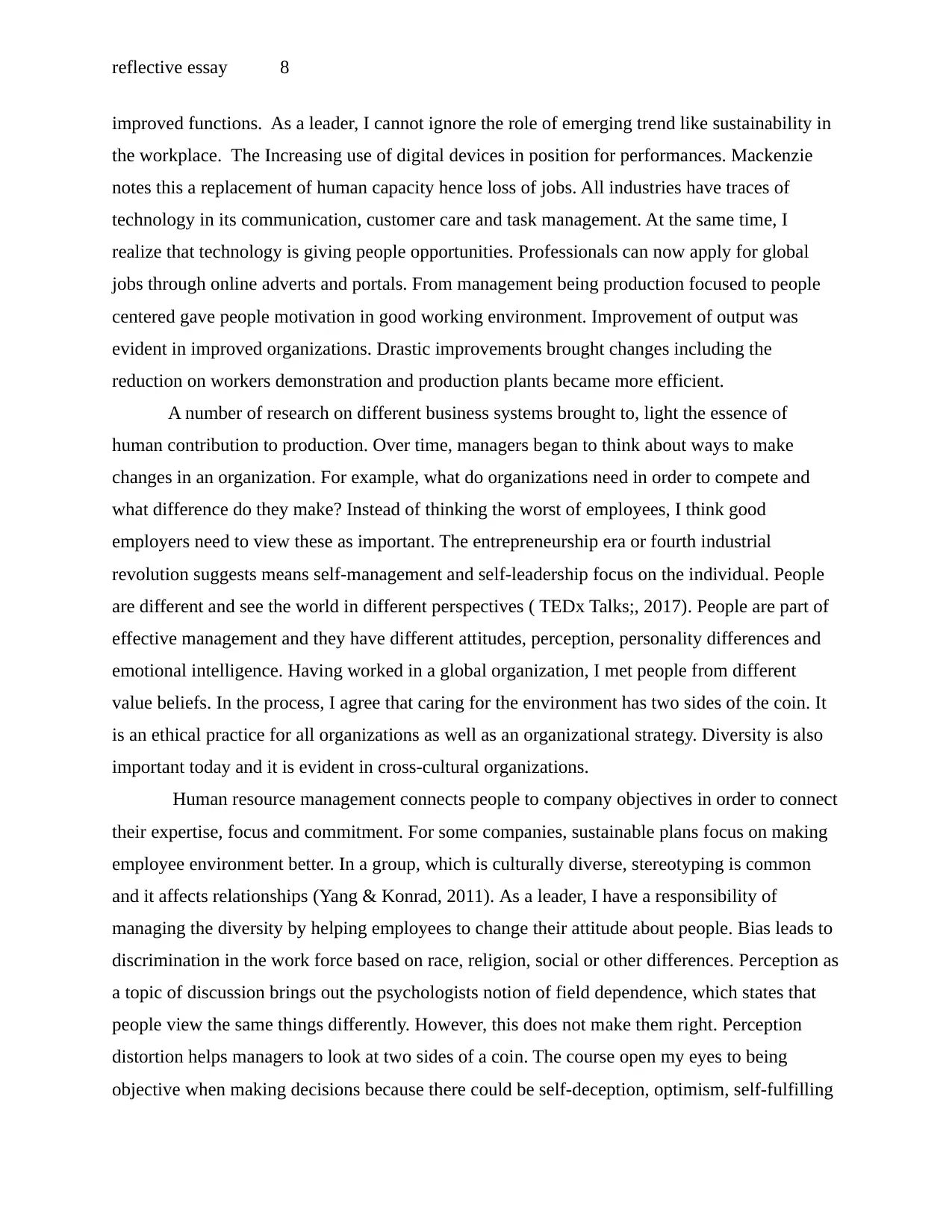
reflective essay 8
improved functions. As a leader, I cannot ignore the role of emerging trend like sustainability in
the workplace. The Increasing use of digital devices in position for performances. Mackenzie
notes this a replacement of human capacity hence loss of jobs. All industries have traces of
technology in its communication, customer care and task management. At the same time, I
realize that technology is giving people opportunities. Professionals can now apply for global
jobs through online adverts and portals. From management being production focused to people
centered gave people motivation in good working environment. Improvement of output was
evident in improved organizations. Drastic improvements brought changes including the
reduction on workers demonstration and production plants became more efficient.
A number of research on different business systems brought to, light the essence of
human contribution to production. Over time, managers began to think about ways to make
changes in an organization. For example, what do organizations need in order to compete and
what difference do they make? Instead of thinking the worst of employees, I think good
employers need to view these as important. The entrepreneurship era or fourth industrial
revolution suggests means self-management and self-leadership focus on the individual. People
are different and see the world in different perspectives ( TEDx Talks;, 2017). People are part of
effective management and they have different attitudes, perception, personality differences and
emotional intelligence. Having worked in a global organization, I met people from different
value beliefs. In the process, I agree that caring for the environment has two sides of the coin. It
is an ethical practice for all organizations as well as an organizational strategy. Diversity is also
important today and it is evident in cross-cultural organizations.
Human resource management connects people to company objectives in order to connect
their expertise, focus and commitment. For some companies, sustainable plans focus on making
employee environment better. In a group, which is culturally diverse, stereotyping is common
and it affects relationships (Yang & Konrad, 2011). As a leader, I have a responsibility of
managing the diversity by helping employees to change their attitude about people. Bias leads to
discrimination in the work force based on race, religion, social or other differences. Perception as
a topic of discussion brings out the psychologists notion of field dependence, which states that
people view the same things differently. However, this does not make them right. Perception
distortion helps managers to look at two sides of a coin. The course open my eyes to being
objective when making decisions because there could be self-deception, optimism, self-fulfilling
improved functions. As a leader, I cannot ignore the role of emerging trend like sustainability in
the workplace. The Increasing use of digital devices in position for performances. Mackenzie
notes this a replacement of human capacity hence loss of jobs. All industries have traces of
technology in its communication, customer care and task management. At the same time, I
realize that technology is giving people opportunities. Professionals can now apply for global
jobs through online adverts and portals. From management being production focused to people
centered gave people motivation in good working environment. Improvement of output was
evident in improved organizations. Drastic improvements brought changes including the
reduction on workers demonstration and production plants became more efficient.
A number of research on different business systems brought to, light the essence of
human contribution to production. Over time, managers began to think about ways to make
changes in an organization. For example, what do organizations need in order to compete and
what difference do they make? Instead of thinking the worst of employees, I think good
employers need to view these as important. The entrepreneurship era or fourth industrial
revolution suggests means self-management and self-leadership focus on the individual. People
are different and see the world in different perspectives ( TEDx Talks;, 2017). People are part of
effective management and they have different attitudes, perception, personality differences and
emotional intelligence. Having worked in a global organization, I met people from different
value beliefs. In the process, I agree that caring for the environment has two sides of the coin. It
is an ethical practice for all organizations as well as an organizational strategy. Diversity is also
important today and it is evident in cross-cultural organizations.
Human resource management connects people to company objectives in order to connect
their expertise, focus and commitment. For some companies, sustainable plans focus on making
employee environment better. In a group, which is culturally diverse, stereotyping is common
and it affects relationships (Yang & Konrad, 2011). As a leader, I have a responsibility of
managing the diversity by helping employees to change their attitude about people. Bias leads to
discrimination in the work force based on race, religion, social or other differences. Perception as
a topic of discussion brings out the psychologists notion of field dependence, which states that
people view the same things differently. However, this does not make them right. Perception
distortion helps managers to look at two sides of a coin. The course open my eyes to being
objective when making decisions because there could be self-deception, optimism, self-fulfilling
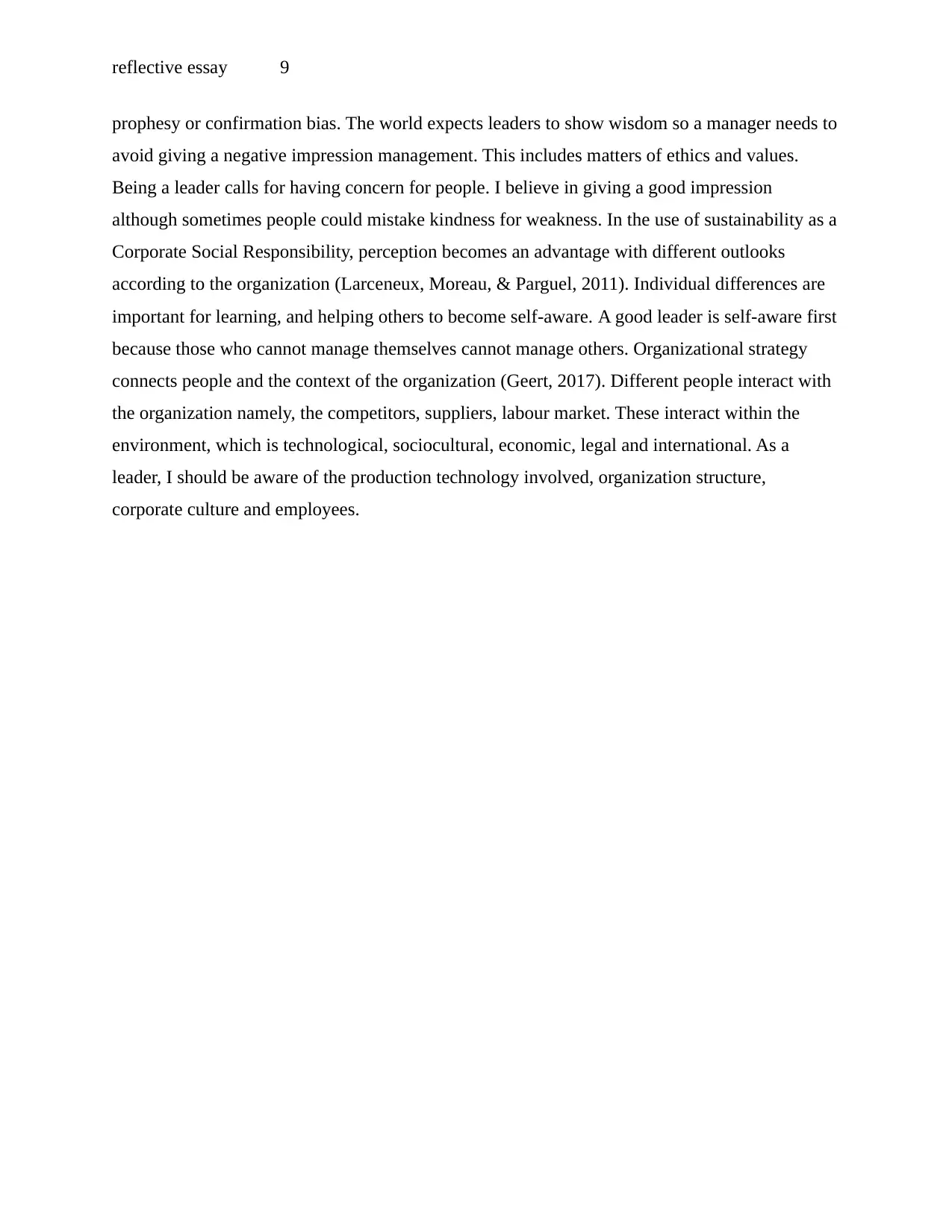
reflective essay 9
prophesy or confirmation bias. The world expects leaders to show wisdom so a manager needs to
avoid giving a negative impression management. This includes matters of ethics and values.
Being a leader calls for having concern for people. I believe in giving a good impression
although sometimes people could mistake kindness for weakness. In the use of sustainability as a
Corporate Social Responsibility, perception becomes an advantage with different outlooks
according to the organization (Larceneux, Moreau, & Parguel, 2011). Individual differences are
important for learning, and helping others to become self-aware. A good leader is self-aware first
because those who cannot manage themselves cannot manage others. Organizational strategy
connects people and the context of the organization (Geert, 2017). Different people interact with
the organization namely, the competitors, suppliers, labour market. These interact within the
environment, which is technological, sociocultural, economic, legal and international. As a
leader, I should be aware of the production technology involved, organization structure,
corporate culture and employees.
prophesy or confirmation bias. The world expects leaders to show wisdom so a manager needs to
avoid giving a negative impression management. This includes matters of ethics and values.
Being a leader calls for having concern for people. I believe in giving a good impression
although sometimes people could mistake kindness for weakness. In the use of sustainability as a
Corporate Social Responsibility, perception becomes an advantage with different outlooks
according to the organization (Larceneux, Moreau, & Parguel, 2011). Individual differences are
important for learning, and helping others to become self-aware. A good leader is self-aware first
because those who cannot manage themselves cannot manage others. Organizational strategy
connects people and the context of the organization (Geert, 2017). Different people interact with
the organization namely, the competitors, suppliers, labour market. These interact within the
environment, which is technological, sociocultural, economic, legal and international. As a
leader, I should be aware of the production technology involved, organization structure,
corporate culture and employees.
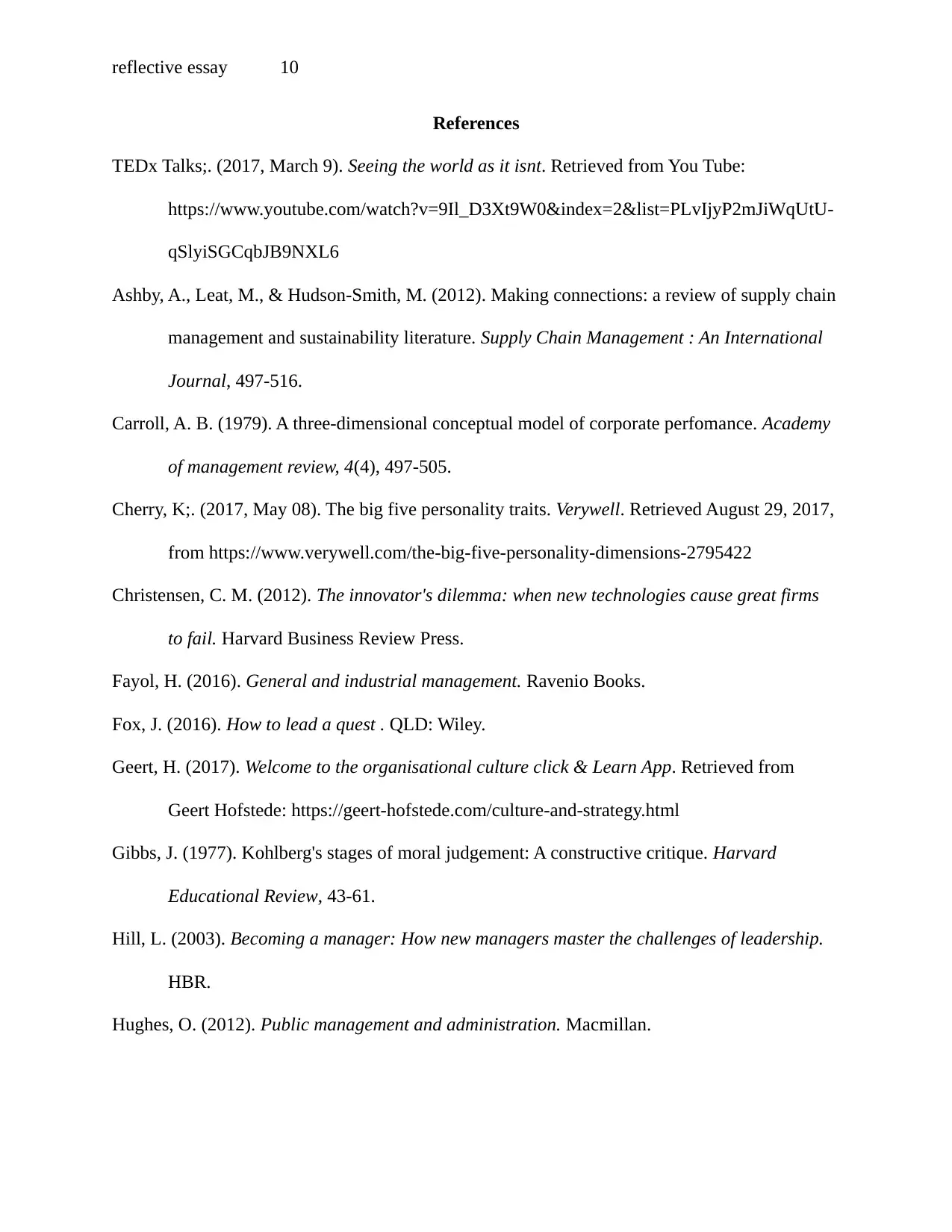
reflective essay 10
References
TEDx Talks;. (2017, March 9). Seeing the world as it isnt. Retrieved from You Tube:
https://www.youtube.com/watch?v=9Il_D3Xt9W0&index=2&list=PLvIjyP2mJiWqUtU-
qSlyiSGCqbJB9NXL6
Ashby, A., Leat, M., & Hudson-Smith, M. (2012). Making connections: a review of supply chain
management and sustainability literature. Supply Chain Management : An International
Journal, 497-516.
Carroll, A. B. (1979). A three-dimensional conceptual model of corporate perfomance. Academy
of management review, 4(4), 497-505.
Cherry, K;. (2017, May 08). The big five personality traits. Verywell. Retrieved August 29, 2017,
from https://www.verywell.com/the-big-five-personality-dimensions-2795422
Christensen, C. M. (2012). The innovator's dilemma: when new technologies cause great firms
to fail. Harvard Business Review Press.
Fayol, H. (2016). General and industrial management. Ravenio Books.
Fox, J. (2016). How to lead a quest . QLD: Wiley.
Geert, H. (2017). Welcome to the organisational culture click & Learn App. Retrieved from
Geert Hofstede: https://geert-hofstede.com/culture-and-strategy.html
Gibbs, J. (1977). Kohlberg's stages of moral judgement: A constructive critique. Harvard
Educational Review, 43-61.
Hill, L. (2003). Becoming a manager: How new managers master the challenges of leadership.
HBR.
Hughes, O. (2012). Public management and administration. Macmillan.
References
TEDx Talks;. (2017, March 9). Seeing the world as it isnt. Retrieved from You Tube:
https://www.youtube.com/watch?v=9Il_D3Xt9W0&index=2&list=PLvIjyP2mJiWqUtU-
qSlyiSGCqbJB9NXL6
Ashby, A., Leat, M., & Hudson-Smith, M. (2012). Making connections: a review of supply chain
management and sustainability literature. Supply Chain Management : An International
Journal, 497-516.
Carroll, A. B. (1979). A three-dimensional conceptual model of corporate perfomance. Academy
of management review, 4(4), 497-505.
Cherry, K;. (2017, May 08). The big five personality traits. Verywell. Retrieved August 29, 2017,
from https://www.verywell.com/the-big-five-personality-dimensions-2795422
Christensen, C. M. (2012). The innovator's dilemma: when new technologies cause great firms
to fail. Harvard Business Review Press.
Fayol, H. (2016). General and industrial management. Ravenio Books.
Fox, J. (2016). How to lead a quest . QLD: Wiley.
Geert, H. (2017). Welcome to the organisational culture click & Learn App. Retrieved from
Geert Hofstede: https://geert-hofstede.com/culture-and-strategy.html
Gibbs, J. (1977). Kohlberg's stages of moral judgement: A constructive critique. Harvard
Educational Review, 43-61.
Hill, L. (2003). Becoming a manager: How new managers master the challenges of leadership.
HBR.
Hughes, O. (2012). Public management and administration. Macmillan.
Secure Best Marks with AI Grader
Need help grading? Try our AI Grader for instant feedback on your assignments.
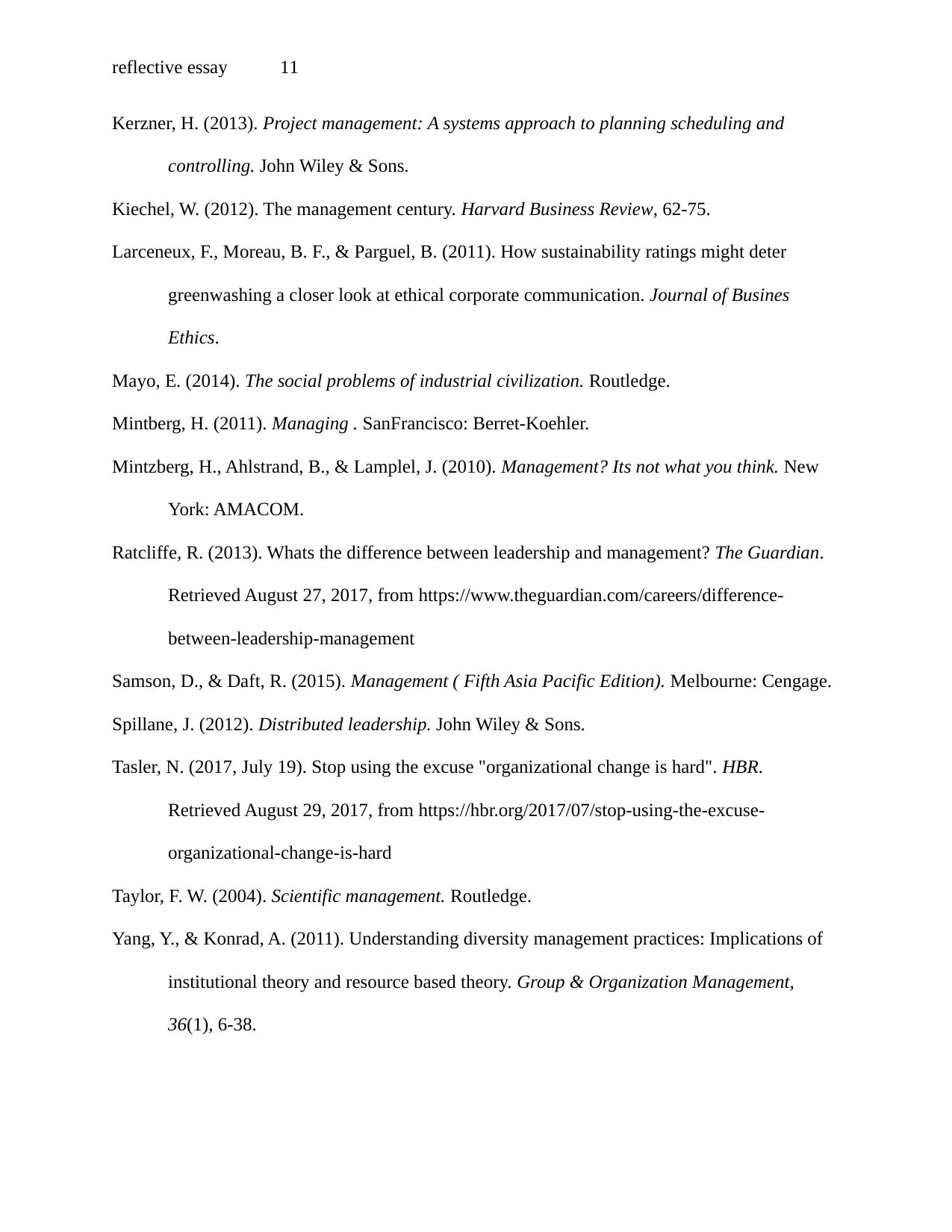
reflective essay 11
Kerzner, H. (2013). Project management: A systems approach to planning scheduling and
controlling. John Wiley & Sons.
Kiechel, W. (2012). The management century. Harvard Business Review, 62-75.
Larceneux, F., Moreau, B. F., & Parguel, B. (2011). How sustainability ratings might deter
greenwashing a closer look at ethical corporate communication. Journal of Busines
Ethics.
Mayo, E. (2014). The social problems of industrial civilization. Routledge.
Mintberg, H. (2011). Managing . SanFrancisco: Berret-Koehler.
Mintzberg, H., Ahlstrand, B., & Lamplel, J. (2010). Management? Its not what you think. New
York: AMACOM.
Ratcliffe, R. (2013). Whats the difference between leadership and management? The Guardian.
Retrieved August 27, 2017, from https://www.theguardian.com/careers/difference-
between-leadership-management
Samson, D., & Daft, R. (2015). Management ( Fifth Asia Pacific Edition). Melbourne: Cengage.
Spillane, J. (2012). Distributed leadership. John Wiley & Sons.
Tasler, N. (2017, July 19). Stop using the excuse "organizational change is hard". HBR.
Retrieved August 29, 2017, from https://hbr.org/2017/07/stop-using-the-excuse-
organizational-change-is-hard
Taylor, F. W. (2004). Scientific management. Routledge.
Yang, Y., & Konrad, A. (2011). Understanding diversity management practices: Implications of
institutional theory and resource based theory. Group & Organization Management,
36(1), 6-38.
Kerzner, H. (2013). Project management: A systems approach to planning scheduling and
controlling. John Wiley & Sons.
Kiechel, W. (2012). The management century. Harvard Business Review, 62-75.
Larceneux, F., Moreau, B. F., & Parguel, B. (2011). How sustainability ratings might deter
greenwashing a closer look at ethical corporate communication. Journal of Busines
Ethics.
Mayo, E. (2014). The social problems of industrial civilization. Routledge.
Mintberg, H. (2011). Managing . SanFrancisco: Berret-Koehler.
Mintzberg, H., Ahlstrand, B., & Lamplel, J. (2010). Management? Its not what you think. New
York: AMACOM.
Ratcliffe, R. (2013). Whats the difference between leadership and management? The Guardian.
Retrieved August 27, 2017, from https://www.theguardian.com/careers/difference-
between-leadership-management
Samson, D., & Daft, R. (2015). Management ( Fifth Asia Pacific Edition). Melbourne: Cengage.
Spillane, J. (2012). Distributed leadership. John Wiley & Sons.
Tasler, N. (2017, July 19). Stop using the excuse "organizational change is hard". HBR.
Retrieved August 29, 2017, from https://hbr.org/2017/07/stop-using-the-excuse-
organizational-change-is-hard
Taylor, F. W. (2004). Scientific management. Routledge.
Yang, Y., & Konrad, A. (2011). Understanding diversity management practices: Implications of
institutional theory and resource based theory. Group & Organization Management,
36(1), 6-38.
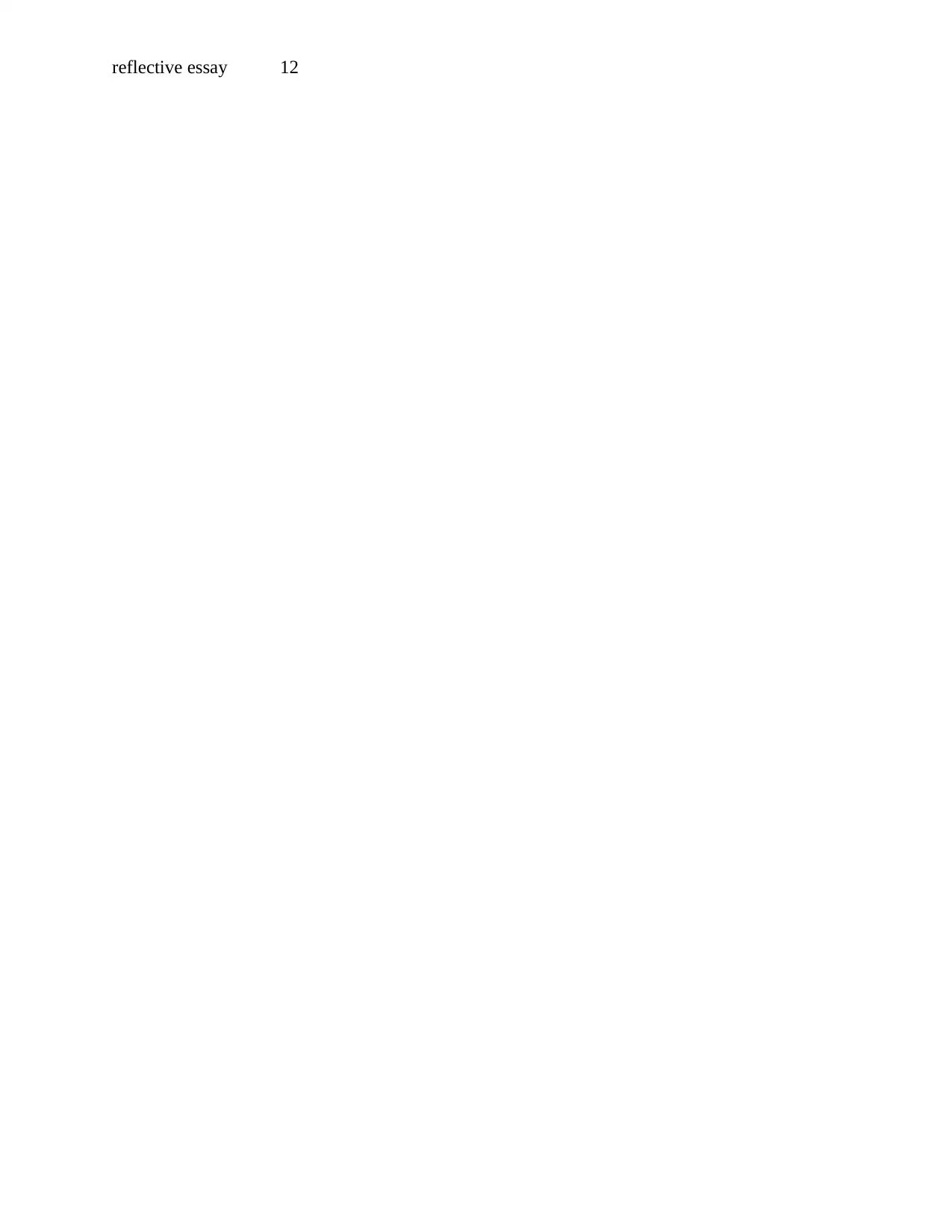
reflective essay 12
1 out of 12
Related Documents
Your All-in-One AI-Powered Toolkit for Academic Success.
+13062052269
info@desklib.com
Available 24*7 on WhatsApp / Email
![[object Object]](/_next/static/media/star-bottom.7253800d.svg)
Unlock your academic potential
© 2024 | Zucol Services PVT LTD | All rights reserved.





